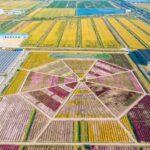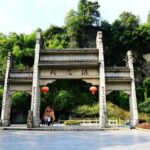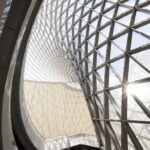Enze Buddhist Temple is located on the north bank of Tianmu Lake. Its appearance combines Chinese temples and Thai temples, which is relatively special. While praying for blessings and peace, you can also experience exotic customs.
The temple was built during the Tianjian period (502-519) of Emperor Wu of Liang in the Southern Dynasties. The original site was located in Jiuxian Village, 25 kilometers northwest of Liyang City. In the fifth year of Yuanyou in the Song Dynasty (1090), it was moved to Huangjia Village in Liyang Town and renamed ‘Qinguang Temple’. During the Xuanhe period of the Song Dynasty (1119-1125), it was called Shenxiao Palace. Later, it was renamed to its original name according to the example. Prime Minister Li Gang wrote a plaque. In the Yuan Dynasty, Enze Temple flourished again. Qiu Yuan, a native of Qiantang, Zhejiang Province and a professor in Liyang Prefecture, wrote a poem titled ‘Inscription on the Abbot of Enze Temple Quan Gong’, praising Liyang as a place with many treasures. Enze Temple is the treasure among the treasures of Liyang. In 1994, the temple was moved to the bank of Tianmu Lake. Making full use of the natural environment and geographical advantages of the foothills of Dongling Mountain, it was built into a new Enze Buddhist Temple with the architectural style of Thai temples of Theravada Buddhism and integrating the cultural characteristics of Chinese Mahayana Buddhism. The historical relics of Enze Buddhist Temple include: stone well fence, built in the sixth year of Yuanhe in the Tang Dynasty (811). There is an inscription on it. It is made of mushroom stone and has a simple and unsophisticated shape. It was listed as a protected cultural relic in Jiangsu Province in 1957; stone tortoise (i.e. Bixi), with a volume of 7.5 cubic meters. It was originally used as a stele base. Now a new stele is erected again, engraved with ‘Records of the Reconstruction of Enze Buddhist Temple’. Today’s Enze Temple, from the panoramic view of the landform, is just like an armchair. The mountain behind is like the back of the armchair, and the hills on both sides are like the armrests on both sides of the armchair. The temple has become a place where tourists linger and forget to return. It is also a good place for Buddhists to practice with concentration. Opening hours: Open all year round from 6:00 to 17:30.Enze Buddhist Temple
Enze Buddhist Temple is located on the north bank of Tianmu Lake. Its appearance combines Chinese te[...]









